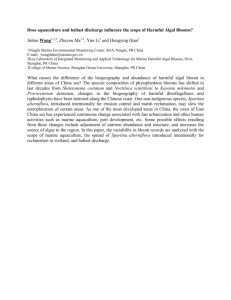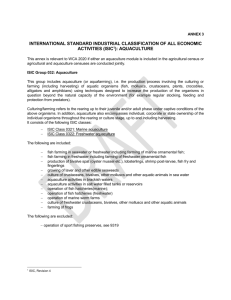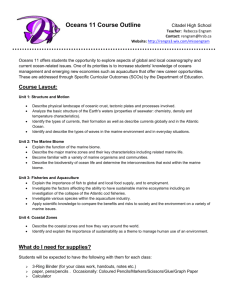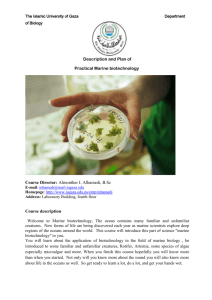coastal aquaculture and marine biotechnolofy
advertisement
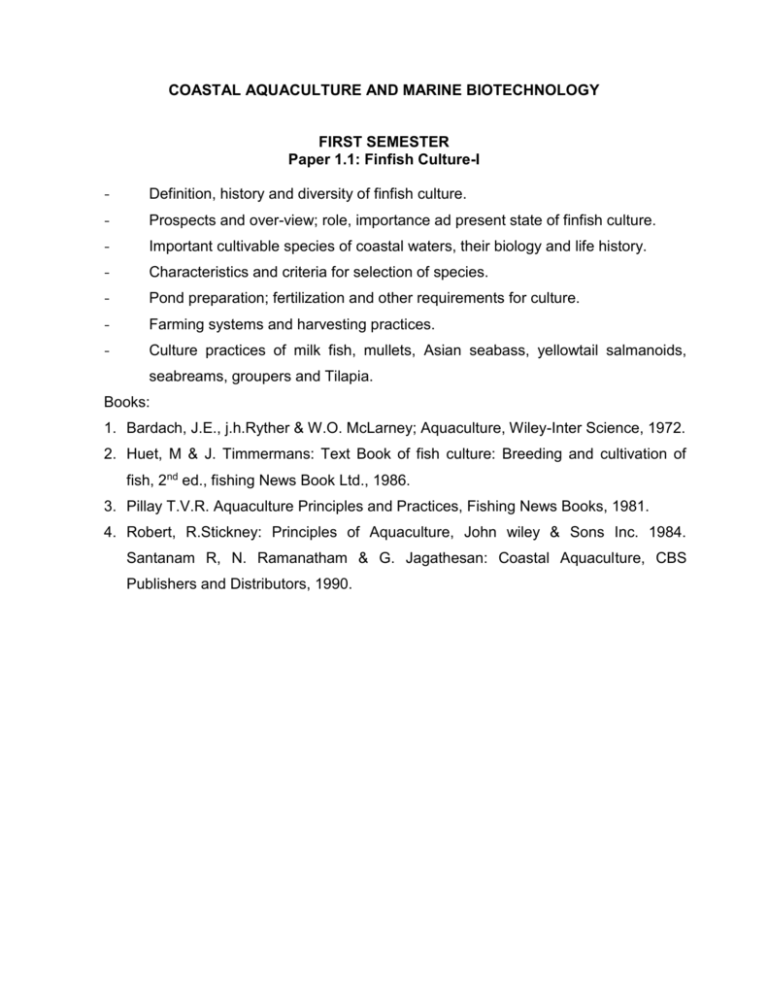
COASTAL AQUACULTURE AND MARINE BIOTECHNOLOGY FIRST SEMESTER Paper 1.1: Finfish Culture-I - Definition, history and diversity of finfish culture. - Prospects and over-view; role, importance ad present state of finfish culture. - Important cultivable species of coastal waters, their biology and life history. - Characteristics and criteria for selection of species. - Pond preparation; fertilization and other requirements for culture. - Farming systems and harvesting practices. - Culture practices of milk fish, mullets, Asian seabass, yellowtail salmanoids, seabreams, groupers and Tilapia. Books: 1. Bardach, J.E., j.h.Ryther & W.O. McLarney; Aquaculture, Wiley-Inter Science, 1972. 2. Huet, M & J. Timmermans: Text Book of fish culture: Breeding and cultivation of fish, 2nd ed., fishing News Book Ltd., 1986. 3. Pillay T.V.R. Aquaculture Principles and Practices, Fishing News Books, 1981. 4. Robert, R.Stickney: Principles of Aquaculture, John wiley & Sons Inc. 1984. Santanam R, N. Ramanatham & G. Jagathesan: Coastal Aquaculture, CBS Publishers and Distributors, 1990. Paper 1.2: Crustacean Farming Books: 1. 2. 3. 4. Status of shellfish farming Important cultivable species of shrimp, their biology, food & feeding and reproductive biology. Types of shrimp farming – traditional, extensive, semi intensive and intensive methods; management. Culture in race ways, cages, re-circulatory systems, rice field, super-intensive and ultra-intensive. Supplementary feeding: dry feeds, wet feeds, role of artificial feeds. Feed ingredients, nutritional quality. Culture of Macrobrachium: crab farming; lobster farming; Crayfish culture. Harvesting, post harvest technology, quality control; production and economics. Use of antibiotics & other chemicals in culture and their impact. Shigueno K: Shrimp Culture of Japan. Association for International Technical Promotion Tokyo. Milne P.H.: Fish and Shellfish Farming in Coastal Waters, Fishing News Ltd., 1972. Hanson J.A. & H.Goodwin: Shrimp and Prawn farming in the Western Hemisphere. Hutchinson & Ross 1977. Korringa P: Farming Marine Fishes and Shrimps, Elsevier Publ. Co. 1976. Paper 1.3 : Aquaculture Engineering – I - Culture systems: Ponds, tanks, estuaries and brackish waters; shore, interidal, sublittoral, surface floating, midwater and seabed: their characteristics and topographical features. - Survey and site selection: Technical considerations, topography, soil structure, water quality and dynamics; seed availability, productivity of the area. - Non-technical considerations – Socio-economic, political and legal aspects. - Principles and procedures of engineering survey: Planning of survey in inland and coastal regions, computation of area, volume and cost estimates. - Fundamental aspects of tides, waves and non-tidal currents, tidal gradients, principles of wave and wind energies; water requirements for filling and drainage of ponds. Hydrology of coastal waters and other brackish water areas. - Engineering survey for the construction of raceways, pens, cages, rafts, long lines etc. Selection of material and equipment: Materials for enclosures, support, retention and other related structures: choice, properties and strength of materials, surface floating units, anchorages, and their quality and durability. - Water flow and level instrumentation; flow measurements through notches and orifices; hydrological parameters, pumps and accessories, aeration and aerators. - Filtration and water treat equipment, water quality monitoring equipment. Books: 1. Milne P.H.:Fish and Shellfish Farming in Coastal Waters, Fishing News Ltd., 1972. 2. Pillary T.V.R. Aquaculture Principles and Practices, Fishing News Books, 1981. 3. Wheaton F.W.: Aquaculture Engineering, Wiley-Inter Science, 1977. 4. E.A. Baliyut: Aquaculture systems and practices – A selected Review, FAO, Rome, 1989. Reprinted by Dayal Publishing House, New Delhi, 1995. Paper 1.4: Mariculture - Coastal and open sea farming: overview contemporary global development in Mariculture. - Perspectives on open sea mariculture. Science and Technology importance to open sea mariculture; Crop selection, controlling the biological environment; platforms, housing and energy for mariculture. - Culture practices in brackish water ponds in Japan, Philipines, Taiwan, Indonesia and India. - Management of brackish water ponds: Pond management in tropical waters, pond preparation, eradication of predators, stocking, use of fertilizers, feed, feeding rates etc. - Role of chemical fertilizers and organic manures in ponds. Water quality management. - Nutritional requirements of finfish and shellfish. - Prospects for the future. Laws pertaining to the aquaculture. Laws pertaining to exploitation of living resources. Books: 1. Bardach J.E., J.H.Ryther & W.O.McLarney: Aquaculture, Wiley-Inter Science, 1972. 2. Pillary T.V.R.Aquaculture Principles and Practices, Fishing News Books, 1981. 3. Mathew Landau: Introduction to Aquaculture John Wiley & Sons, Inc. 1991. Paper 1.5 : Reproduction of Culture Organisms. - Reproductive Biology of Finfishes – Mullets, Milkfish, seabass, Tilapia, Groupers. - Crustaceans – Shrimps, prawns, crabs and lobsters. - Molluscs – Oysters, mussels and cephalopods and Echinoderms – sea cucumbers. - General account of physiology of reproduction in finfish and shellfish. - Endocrine control of reproduction in finfish and shellfish. - Role of hormones in controlled spawning. - Induced breeding in finfish and shellfish. - Sex control and its role in aquaculture, sex steroids. - In-vitro fertilization, artificial insemination. - Cryobiology; cryopreservation of sperms and embryos. Books: 1. Bardach J.E., J.H. Ryther & W.O. McLarney: Aquaculture, Wiley-Inter Science, 1972. 2. Jhingran, V.G.: Fish and Fisheries of India, 2nd ed., Hidustan, 1982. 3. Mathew Landau 1991: Introduction to Aquaculture John Wiley & Sons, Inc. 4. Imai, 1977 T: Aquaculture in shallow seas, Amerind Pub. Co. SECOND SEMISTER Paper 2.1 : Finfish Culture – II - Classification of culture systems: Ponds, cages, pens, raceways. - Eradication of weed fishes, predatory fishes, aquatic weeds and insects. - Sea ranching; farm management. - Monoculture; mono-sex culture; polyculture, characteristics of species selected for polyculture, stocking density and ration. - Integrated farming, organic farming, selection of species, techniques, management benefits. - Harvesting, post-harvesting technology; quality control - Marketing; production and economics. Books: 1. Huet M & J. Timmermans: Text book of fish culture: Breeding and cultivation of fish, 2nd ed., fishing News Book Ltd., 1986. 2. Jhingran V.G.: Fish and Fisheries of India, 2nd ed., Hindustan, 1982. 3. James P.Mcvey (Ed) : CRC Hand book of Mariculture, Vol.2, Finfish Aquaculture, CRC Press, Boca Raton, 1991. Paper 2.2 : Molluscan and Seaweed Farming - Present status of molluscan farming; life cycles of cultivable mollusks. - Oyster and mussel farming, growth, fattening, greening. - Culture of pearl-oyster and pearl production. - Water quality management and biofouling. - Harvesting, post-harvest technology, production, economics. - Seaweed farming: present status - Life cycle of cultivable molluscs and seaweeds - Culture practices of seaweeds in India & abroad, improvement of breed. - Harvesting, post-harvesting technology, management, production and economics. Books: 1. Bardach J.E., J.H.Ryther & W.O. McLarney: Aquaculgture, Wley-Inter Science, 1972. 2. Milne P.H.: Fish and Shellfish Farming in Coastal Waters, Fishing News Ltd., 1972. 3. Walne P.R.: Culture of Bivalve Molluscs, Publishing News Books Ltd., 1976. Paper 2.3 Aquaculture Engineering – II - Design and construction of farm ponds and hatcheries: (a) Farms: Laying out of pond bottom, design and construction of dykes, water control structures, drainage installations, spillway, monk etc. - By-pass channels, water inlet channels, sedimentation and treatment tanks, desiltation. - Design of farms under different culture systems. - Design and construction of raceways, cages, pens etc. - Hatcheries: finfish, shellfish and seaweeds. - Open-sea farming engineering: Selection of sites, factors to be considered for location: selection of materials; marine corrosion and its control; sedimentation and its control; marine fouling and its control. - Design, fabrication and construction of racks, rafts and long-lines. - Net retaining structures; Constraints and prospects of open – sea farming. Books: 1. Bardach J.E., J.H. Ryther & W.O. Mclarney: Aquaculture, Wiley-Inter Science, 1972. 2. Jhingran V.G.: Fish and Fisheries of India, 2nd ed., Hindustan, 1982. 3. Pillay T.V.R. & Wm. A. Dill; Advances in Aquaculture, FAO, 1979. Paper 2.4 : Seed Production and Hatchery Management - Seed production: wild seed collection methods of mullets, milk fish, seabass, shrimps, crabs, lobsters, oysters, pearl-oysters, mussels, sea weeds. - Impact of exploitation of wild seed and brood stock on environment and on sustainable yields. - Hatchery management and seed production of mullets, milk fish, seabass, shrimps, crabs, lobsters, oysters, pearl oysters, mussels, sea weeds. - Use of fertilizers, feed and nutrition, harvesting of fry, packaging and transport of fry, small-scale hatcheries. Nursery management: Preparation of nurseries, effects of physico-chemical factors, feeding and control of predators. Books: 1. Bardach J.E., J.H.Ryther & W.O. McLarney: Aquaculture, Wiley-Inter Science, 1972. 2. Pillary T.V.R.Aquaculture Principles and Practices, Fishing News Books, 1981. 3. Imai T: Aquaculture in shallow seas, Amerind Pub.Co. 1977. Paper 2.5 : Genetics in Aquaculture - DNA structure, replication, damage and repair, gene expression. - Gene amplification and rearrangement. - Genetic principles and fish cytogenetics - Role of genetics in aquaculture. Genetic selection. - In-breeding, crossbreeding. Hybridization, hybrid vigour. - Induction of ploidy, production of polyploids. - Chromosome set manipulation – gynogenesis and andorgenesis. - Transgenesis and its application in aquaculture to produce more growth, coldresistant, and disease-resistant varieties. - Genetic modifications in sea weeds; application to commercial utilization and cultivation. Books: 1. Jhingran V.G: Fish and Fisheries of India, 2nd ed, Hindustan, 1982. 2. Pillay T.V.R. Aquaculture Principles and Practices, Fishing News Books, 1981. 3. Kirpichnikov V.S.: Genetic Bases of Fish Selection, Springer Werlag 1981. Paper 3.1 : Marine Microbiology 1. Microscopes: Types and basic principles 2. Microbes in the sea: Viruses, bacteria, fungi, micro algae and protozoans distribution in the marine environment. 3. Sterilization techniques employed in microbiological studies. 4. Viruses: Morphology, enumeration, isolation, culture, classification 5. Bacteria: Morphology, enumeration, isolation, culture, classification, identification and preservation. 6. Microalgae, fungi and protozoans: Classification and culture. 7. Role of microbes in the marine environment. 8. Methods of controlling microbial organisms: Physical, chemical and chemotherapeutic methods. 9. Microbial decomposition of carbohydrates, proteins and lipids. 10. Mangrove microbiology: Mangrove microbial processes and the organisms involved. Books: 1. Carol D. Litchfield 9Ed.) : Marine Microbiology, Dowden Hutechinson & Ross Inc., 1976. 2. Pillay T.V.R.: Aquaculture principles and practices, Fishing New Books, 1981. 3. McVay, J.P.(Ed.): CRC Handbook of Mariculture Crustacean Aquaculture, CRC Press, 1993. References: 1. M.J.Pelezar, E.C.S. Chan & N.R. – Krirg Microbiology Tata-McGrawhill. 2. Collee, J.G., J.P. Duggerid, A.G.Freaser, B.P.Marmion: Practical Medical Microbiology, Churchil Livingston, 1989. Paper 3.2 : Principles of Biochemistry Biomolecules, carbohydrates, lipids, proteins, vitamins and minerals –structure , - biological significance, role in metabolism , bioenergetics - Moulting and growth, regulating factors. - Analytical techniques,Biomolecular separation, isolation and purification. Chromatography-paper, thin layer ,GLC,HPLC, affinity chromatography - Centrifugation, spectroscopy, fluorescence, nanometry and microtomy. - Microscopy: Light, bright field, phase contrast fluorescence and electron microscopy. - Enzymes- classification, enzyme action, factors affecting enzyme catalysis, control of enzymatic action, immobilization of enzymes, coenzymes, activators and inhibitors, allosteric enzymes, ribozymes and abyzymes. - Digestive physiology of finfishes and shellfishes. Books: 1. Conn E.E. & P.K. Stump: Outlines of Biochemistry, Wiley Interscience, 1972. 2. Hoar W.S.Fish Physiology Vols. I & III, Academic Press, 1969. 3. Jhingran V.G.: Fish and fisheries of India, Hindustan Publ. Corpn. 1991. References: 1. White A.P., Handler, R. ad E.C.Smith: Principles of Biochemistry, McGraw Hill, 1964. 2. Pillay T.V.R. & W.A. Dill: Advances in aquaculture, FAO, 1979. 3. Kripichnikov, V.S.: Genetic bases of fish selection, Springer Verlag, 1981. Paper 3.3 Marine Biotechnology-I - Microbial fermentation, microbes in decomposition and recycling processes, application of biofermenter and biofertilizer. - Microbial transformation process, the structure of fermentation process. - Use of enzymes, selection of sources, enzyme extraction, purification, enzyme application. Biocatalyst reactors, immobilization, application of biocatalysts. - Genetic engineering, gene targeting, approaches in biotechnology, isolation in nuclear and extra nuclear DNA, Gene modification and introduction southern, northern and south-western blots, hybridization, colony hybridization and sequencing of proteins, and nucleic acids, polymerase chain reaction. - Recombinant DNA and genome analysis. cloning. Gene manipulation, molecular Application of DNA technology in aquaculture, transgenic biology, allopheny, production of polyploids. Text Books: 1. M.D. Travan, S.Boffey, K.H.Goulding, P.Stauburry: Biotechnology: The Biological Principles, Tata McGraw Hill Publishing Company Ltd., 1991. 2. Carol D. Litchfield (Ed.) : Marine Microbiology, Dowden, Hutchinson & Ross, Inc., 1976. 3. Bye, V.J. and A. Ponnaiah: Application of Genetics in Aquaculture, CMFRI Special Publication No.13, 1983. References: 1. Jeffrey H.Miller: Experiments in Molecular Genetics, Cold-Spring Harbour Laboratory Press, 1993. 2. Pillay, T.V.R. & Win A.Dill: Advances of Aquaculture, FAO, 1979. 3. Imai, T.: Aquaculture in Shallow Seas, Amevind Pub. Co. 1977. Paper 3.4: Bioactive Marne Natural Products – I Bioactivities of Marine Natural Products. An introduction to the of marine natural products; Antibiotic-tumor, repellent, anti-parasitic, Microbial, antifouling. Commercial potential and development of marine natural products. Chitosan as a biomaterial. Algae products: carrageenan, algin, B-carotene and vitamins. Marine microorganisms as a new biomaterial resources (marine microalgae, fungi and bacteria). Dinoflagellates as a source of bioactive compounds: A brief introduction of isolation, chemistry and pharmacology of saxitoxin, brevitoxin and cigatoxn Tunicromes. Isolation techniques: Liquid – Liquid extraction, membrane separation methods and Chromatography (TLC, HPLC) and conventional techniques. Characterization techniques: IR, UV, NMR, and mass spectra. Books: 1. David H.Attway & Oskar R.Zabosky: Marine Biotechnology: Volume 1,2,3, Plenum Press, 1993. References: 1. P.J.Scheuer: Marine. Natural Products, Volume 1 & 2 (1978). Volume (1980-81) Academic Press. Paper 3.5: Marine Pollution Marine Pollution: Definition by GESAMP, major sources of pollution, dynamics, transport paths and agents. Toxicology: Lethal and sub lethal effects of pollutants on marine organisms, evaluation of toxicity tolerance, bioassay. Enzymatic removal of hazardous organic substances from aqueous effluents. Sewage: Domestic, Industrial, agricultural and aquacultural discharges, their composition and fate in the marine environment, toxicity and treatment methods, sewage disposal system. Environmental Impact Assessment Methods of aquaculture activities. Oil pollution: Sources and fate of oil, composition and toxicity of oil, biological effects treatment procedures. Thermal and radioactive pollutants: Source and characteristics, strategies for disposal of RNA and Heated effluents, biological effects and alternative uses of waste dumping, mining and dredging operations, their effects on the organisms and marine environment. Text Books/References: 1. S.E. Nielsen: Tropical Pollution, 1982. 2. A.M.Chakravarthy Biodegradation and detoxification of Environmental pollutants, CRC Press, 1928. 3. O.Kinne: Marine Ecology, Vol.V.Ocean Management 3&4, John Wiley & Sons, 1984. 4. Johnston R. (Ed.) : Marine Pollution, Academic Press, 1976. 5. Patin. S.A.: Pollution and Biological resources of the Oceans Butterworth & Co. Ltd., 1982. 6. Ruive M. (Ed.) : Marine Pollution and Fishing News Sea Life, 1972. 7. Venugopalan, V.K.: Pollution and Toxicology, CAS in Marine Biology, 1991. 8. Rita Colwell (Ed.): Biotechnology in Marine Sciences, Academic Press, 1981. 9. Prakesh P.: Textbook of Marine Pollution. 10. Gupta, P.K.: Introduction to Biotechnology. FOURTH SEMESTER Paper 4.1: Pathology and Immunology 1. Disease causing agents: Physical, Chemical and Biological 2. Disease diagnostics: Epidemiology, Laboratory studies, microbiological and histopathological studies. 3. Viral, bacterial, fungal and protozoan diseases in marine organisms and their control methods. 4. Chemotherapeutic agents: Types and modes of action. 5. Applications of biotechnology in the diagnosis and control of diseases. 6. Antigens and their general properties. 7. Immunoglobulins: Structure and properties 8. Immunity: natural and acquired; Immunogenetics 9. Cytotoxicity mechanisms. 10. Immunology of invertebrate marine organisms Reference Books: 1. Schoperclans W.fish diseases Vols. 1 & 2, Oxian Press Pub. Ltd. 1981. 2. I.M.Riott Essential of Immunology Blackwell Pub. Paper 4.2 : Molecular Biology - Cell- Structure ,organization, function - Molecular basis of nucleic acids- DNA, RNA , mitochondria, plastids. Ribosomes . Structure, replication, damage and repair. biological membranes, the Gene amplification, rearrangement, cell membranes, nuclear membrane , model membranes, complex membranes ,structures and conservatives. Glycoconjugates and proteins in membrane systems, Ion transport, Na/K phase, molecular basis of signal transduction. - Regulation of gene expression in pro and eukaryotes, attenuation and antitermination. - Operon concept, DNA methylation, Heterochromatinization, regulatory sequences and transacting factors, Evironmental regulationof gene expression - Mechanism of transcription of prokaryotes and eukaryotes. RNA processing ribonucleoproteins, Genetic code, protein synthesis, Bacteriophage Genetics, Transduction, Complementation, Molecular recombination, DNA ligases, topoisomerases, gyrases, methylases, nucleases, restriction endonucleases. Books: 1. J. Paul: Cell Biology, Hinemanu Books Ltd. 1975. 2. D. Frirfelder: Microbial Genetics, 1987. 3. Albert et al. Molecular Biology of the Cells, 1989. 4. De Robertis : Cell and Molecular Biology 5. Watson et al. Molecular Biology of the Gene, Benmamin Cummings Pub. Paper 4.3: Marine Biotechnology – II - Cell and tissue culture primary culture, cell line, cell clones, callus culture, somaclonal culture, micropropagation, somatic embryogenesis, haploidy, protoplast fusion and somatic hybridization, cybrids. - Single cell proteins. Spirulina culture and its nutritional quality. - Techniques in immunology, precipitation reactions, agglutination reactions. - ELISA, RIA, Immuno-electrophoresis, vaccine production and immunization. Immunotherapy, production of monoclonal antibodies, hybridoma technology. - Live feed organisms, requirements, large scale culture methods. Culture of different phytoplankton, zooplankton like Artemia sp. Brachionus sp. Chironomid larvae and their nutritional quality. Books: 1. M.D. Travan, S. Boffey, K.H. Goulding, P.Stauburry: Biotechnology: The Biological Principles, Tata McGraw Hill Publishing Company Ltd., 1991. 2. Carol D. Litchfield (Ed.): Marine Microbiology, Dowden, Hutchinson & Ross, Inc., 1976. 3. Collee, J.G., J.P.Dugerid, A.S. Traven, B.P. Marimion: Practical Medical Microbiology, Churchil Livingston, 1989. References: 1. Sambrook, Fritsch * Maniastes: Molecular Cloning Vols. 1, 2 & 3. Cold spring harbor laboratory press. 1989 2. Pillay, T.V.R. & Win A. Dill: Advances of Aquaculture, FAO, 1979. 3. Imai, T.: Aquaculture in Shallow Seas, Amevind Pub. Co. 1977. Paper 4.4. Bioactive Marine Natural Products - II Bioactive marine natural products: Anti-tumour, tumour promoting, anti- inflammatory, cytotoxic, anti- neoplastic and analgesic compounds. Nitrogen containing marine natural products: Amides, (Symbioramide, mycolamide – A), Tyrosin based metabolites (Aeroplisinin – 1), diagoamides – A and B, Indoles (Herbindoles – A - C) Imadezoles (Girolline), Pyridines (Theonelladines), Peptides (didemnins, Dolastatins), ara – A, nucleosides (toyocamnins), swinholide and macrolides. Non Nitrogenous Bioactive Compounds: polyketides (Dysidazirine, ficulinic acids-A and B, Duryne, Aliphatic esters, peroxides), prostanoides (clavulone –II punaglandin-1, chloro, bromo and iodo vulones). Polyethers (hemibrevitoxin B, lokadaicacid), macrolides (amphidinilide .A. swinholide A, bryostatins) Terpenes, laplysiterpenoid, geranyl hydroquinone. Averol and Averone, curcuphenol, cembranoides, brantheines V&Z, oxygenated sterols and saponins (sarasinoside A, Xeniasterol C, Imbricatosides A and B, cephalostatins). Books: 1. David H.Attway & Oskar R.Zabosky: Marine Biotechnology, Volume 1,2,3, plenum press 1993. References: 1. P.J.Scheuer: Marine Natural Products, Volume 1&2 (1978) Volume (1980, 81), Academic Press. Paper 4.5: Environmental Monitoring and Biodeterloration Global environmental monitoring methods: Status and objectives, limitations for monitoring critical pollutants. Role of biotechnology in environmental pollution control: Indicator organisms, Test organisms, Monitoring organisms, Enzymes. Coastal developmental activities-environmental issues. Micro and Macro fouling, corrosion of metals and alloys in the sea, effects of bio-fouling and bio deterioration on marine structures. Protection methods against corrosion and fouling Application of biotechnology in controlling the bio deterioration of wood and synthetic substances in the sea. Red tides: Cause character and effects on the organisms of Marine environment Text Books/References: 1. S.E. Nielsen: Tropical Pollution, 1982. 2. A.M.Chakravarthy: Biodegradation and detoxification of Environmental pollutants, CRC Press, 1928. 3. o.Kinne: Marine Ecology, Vol.V. Ocean Management 3&4 John Wiley & Sons. 1984. 4. Johnston R. (Ed.) : Marine Pollution, Academic Press, 1976. 5. Patin S.A.: Pollution and Biological resources of the Oceans Butterworth & Co. Ltd., 1982. 6. Ruive M. (Ed.) : Marine Pollution and Fishing News Sea Life 1972. 7. Venugopalan, V.K. : Pollution and Toxicology, CAS in Marine Biology, 1991. 8. Rita Colwell (Ed): Biotechnology in Marine Sciences, Academic Press, 1981. 9. Prakash P.: Textbook of Marine Pollution. 10. Gupta, P.K. : Introduction to Biotechnology.


